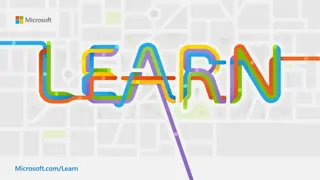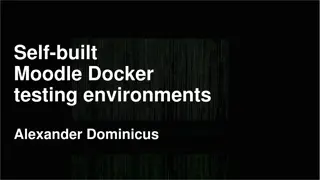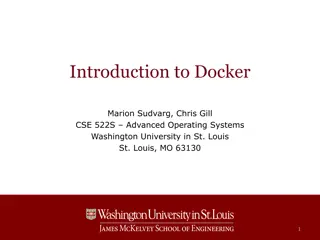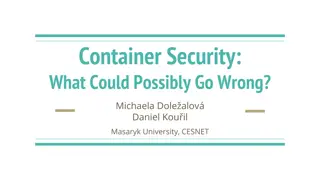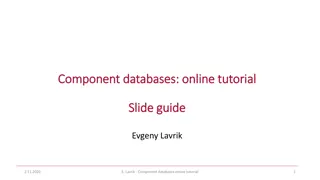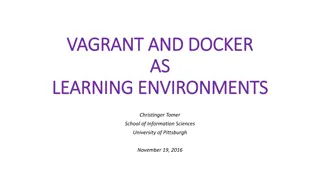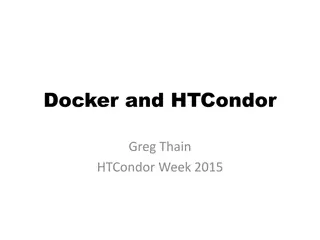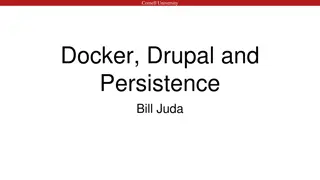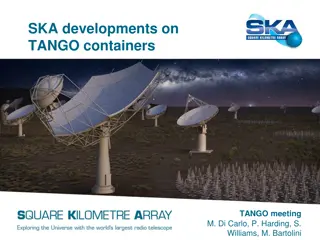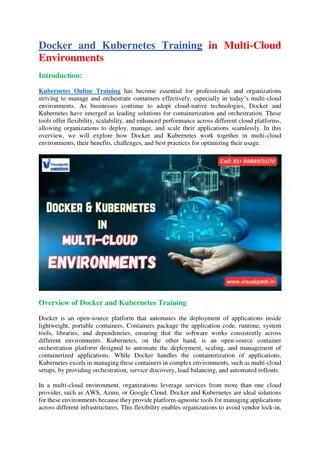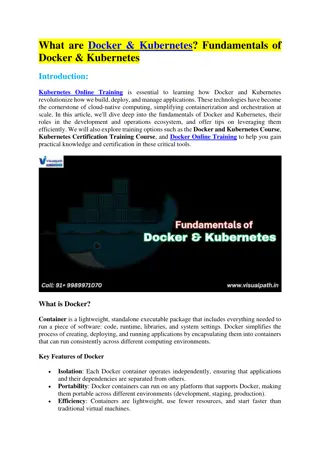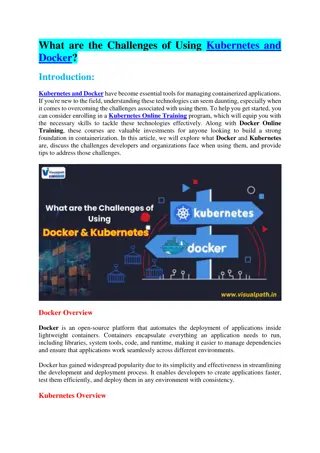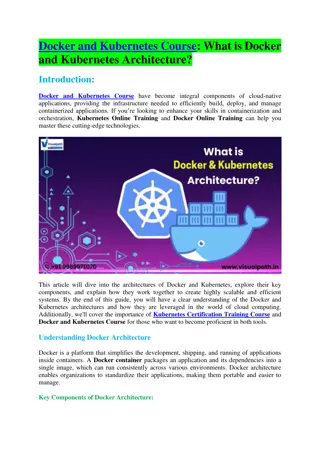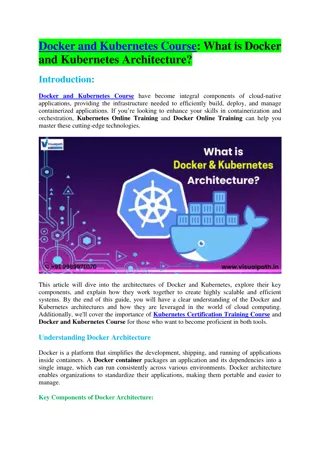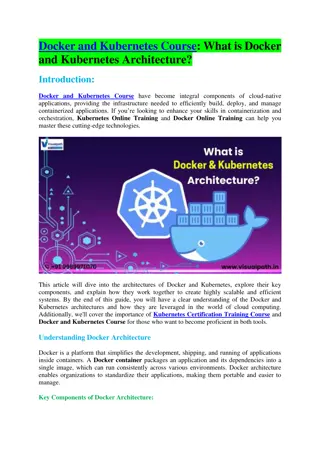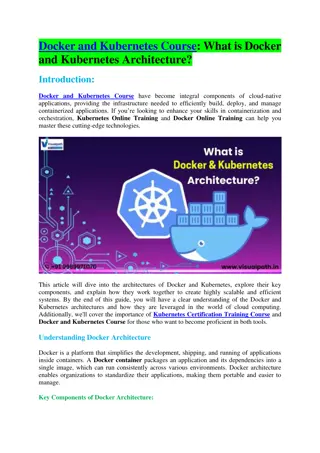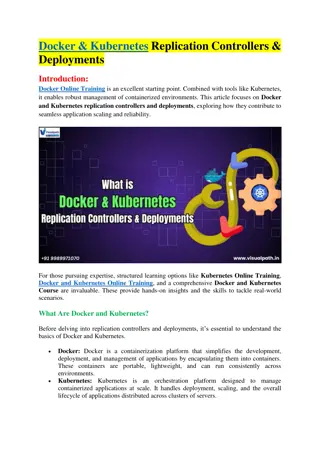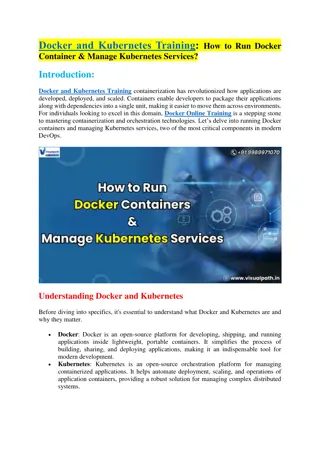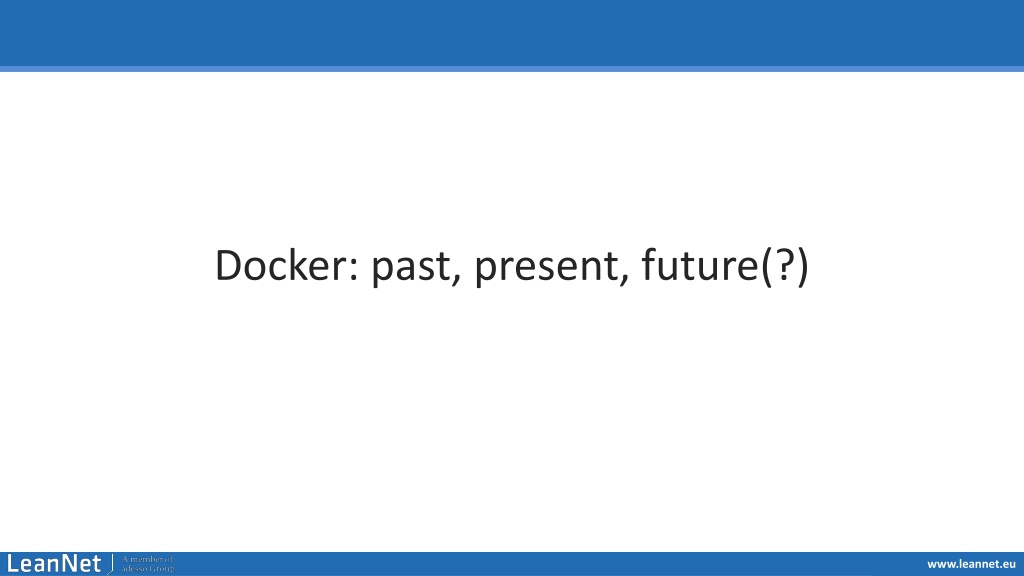
Unveiling the Evolution of Docker: Past, Present, Future
Explore the journey of Docker from its roots in Linux kernel primitives to the innovative containerization technology we know today. Discover the significance of Docker Layers, Namespaces, and Control Groups in simplifying container management. Uncover the history of Docker's development and its impact on the world of cloud computing.
Download Presentation

Please find below an Image/Link to download the presentation.
The content on the website is provided AS IS for your information and personal use only. It may not be sold, licensed, or shared on other websites without obtaining consent from the author. If you encounter any issues during the download, it is possible that the publisher has removed the file from their server.
You are allowed to download the files provided on this website for personal or commercial use, subject to the condition that they are used lawfully. All files are the property of their respective owners.
The content on the website is provided AS IS for your information and personal use only. It may not be sold, licensed, or shared on other websites without obtaining consent from the author.
E N D
Presentation Transcript
Docker: past, present, future(?) www.leannet.eu
Who am I? Co-founder @ LeanNet Ltd. Consulting, training, implementing Cloud Native, Kubernetes, Microservices, DevOps Now part of the szabo@leannet.eu linkedin.com/in/szabvid twitter.com/szabvid www.leannet.eu
What Everyone Knows: Virtual Machines vs. Containers Container: A bundle of the application code along with its runtime and dependencies App 2 App 3 App 1 OS OS OS App 1 App 2 App 3 Container 1 Container 2 Container 3 VM 3 VM 1 VM 2 Container runtime Operating System Hypervisor Physical machine Physical machine www.leannet.eu
Lets Go Deeper Why Docker? Containers are much older than the ones we know and use nowadays: They were created by using Linux kernel primitives: Control Groups Namespaces Namespaces: + Control Groups Makes a global system resource seems as it would belong to one process Similarly as the Hypervisor abstracts away hardware for VMs www.leannet.eu
Lets Go Deeper Why Docker? So even before Docker creating containers were possible, but very struggling! Docker made it very easy, also introducing Docker Layers: read only union file system (UnionFS) to be transparently overlaid, forming a single coherent file system Container Namespaces Control Groups Layers Read Only Image www.leannet.eu
Small History Docker originally wrapped the LXC (low level tools, templates, libs for creating containers) However, at one point LXC development broke Docker so they developed their own substitute libcontainer Docker Namespaces Control Groups UnionFS LXC www.leannet.eu
Small History Docker originally wrapped the LXC (low level tools, templates, libs for creating containers) However, at one point LXC development broke Docker so they developed their own substitute libcontainer Docker Namespaces libcontainer Control Groups UnionFS www.leannet.eu
Small History Docker originally wrapped the LXC (low level tools, templates, libs for creating containers) However, at one point LXC development broke Docker so they developed their own substitute libcontainer Docker became an ecosystem and added many features as a monolith: registry, orchestration, builds, etc. registry runtime Docker orchestration Namespaces libcontainer Control Groups UnionFS images builds compose www.leannet.eu
Small History Docker originally wrapped the LXC (low level tools, templates, libs for creating containers) However, at one point LXC development broke Docker so they developed their own substitute libcontainer Docker became an ecosystem and added many features as a monolith: registry, orchestration, builds, etc. Bad since it is a Monolith registry Conflicted with other Orchestrators runtime Docker orchestration libcontainer UnionFS images builds compose When OCI (Open Container Initiative) came they rewrite their architecture (abandoned libcontainer in 2015) OCI: Linux Foundation project to design open standards for OS-level virtualization www.leannet.eu
Platform and Ecosystem Client-server architecture Client uses CLI to send messages that are translated to REST API calls for the Docker Engine Docker Engine has a modular architecture It manages (here creates) the container Client Docker Engine $ docker run REST API $ docker build $ docker pull Docker daemon runc www.leannet.eu
Platform and Ecosystem Client-server architecture Client uses CLI to send messages that are translated to REST API calls for the Docker Engine Docker Engine has a modular architecture It manages (here creates) the container Registry Docker Host Client Images Docker Engine $ docker run REST API $ docker build $ docker pull Ecosystem: Docker daemon Docker Hub Docker Compose Docker Desktop Compute Services (Docker Swarm) runc Enterprise services/versions www.leannet.eu
Docker Benefits for Microservices and DevOps Example scenario for a modern CI/CD pipeline with Kubernetes and Azure https://docs.microsoft.com/en-us/dotnet/architecture/containerized-lifecycle/docker- devops-workflow/create-ci-cd-pipelines-azure-devops-services-aspnetcore-kubernetes www.leannet.eu
Docker Alternatives Containers: Kata Nabla FireCracker Runtime: CRI-O ContainerD Image build: Kaniko Buildah Conainers and Image management: PodMan www.leannet.eu
Docker Future Docker Enterprise: Was acquired by Mirantis in 2019 Docker Enterprise Engine, Docker Trusted Registry, Docker Unified Control Plane and Docker CLI Docker: Expand Docker Desktop and Docker Hub s roles in the developer workflow for modern apps 2021 March 16: Docker Announces $23M in Series B Funding Containerization landscape has changed a lot: There are many alternatives and heterogeneity E.g. Kubernetes is deprecating Docker Docker still has its leading role: Compatibility, maturity perspective Ecosystem and platform perspective www.leannet.eu

